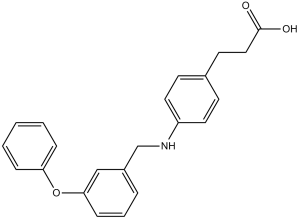GW9508 (GW-9508) is a novel, potent and selective agonist for FFA1 (fatty acid receptor GPR40) with pEC50 of 7.32, and is 100-fold selective against GPR120, it stimulates insulin secretion in a glucose-sensitive manner. GW9508 is a GPR40/120 agonist and is different from the reported GPR40/120 agonist GW1100. When tested with HEK-293 (human embryonic kidney) cells expressing GPR40 or GRP120, GW9508 treatment increased intracellular Ca2+ concentration via activating GPR40/120 in a dose-dependent manner.
Physicochemical Properties
| Molecular Formula | C22H21NO3 | |
| Molecular Weight | 347.41 | |
| Exact Mass | 347.152 | |
| CAS # | 885101-89-3 | |
| Related CAS # |
|
|
| PubChem CID | 11595431 | |
| Appearance | White to off-white solid powder | |
| Density | 1.2±0.1 g/cm3 | |
| Boiling Point | 538.4±45.0 °C at 760 mmHg | |
| Flash Point | 279.4±28.7 °C | |
| Vapour Pressure | 0.0±1.5 mmHg at 25°C | |
| Index of Refraction | 1.641 | |
| LogP | 4.74 | |
| Hydrogen Bond Donor Count | 2 | |
| Hydrogen Bond Acceptor Count | 4 | |
| Rotatable Bond Count | 8 | |
| Heavy Atom Count | 26 | |
| Complexity | 414 | |
| Defined Atom Stereocenter Count | 0 | |
| InChi Key | DGENZVKCTGIDRZ-UHFFFAOYSA-N | |
| InChi Code | InChI=1S/C22H21NO3/c24-22(25)14-11-17-9-12-19(13-10-17)23-16-18-5-4-8-21(15-18)26-20-6-2-1-3-7-20/h1-10,12-13,15,23H,11,14,16H2,(H,24,25) | |
| Chemical Name | 3-(4-((3-phenoxybenzyl)amino)phenyl)propanoic acid | |
| Synonyms |
|
|
| HS Tariff Code | 2934.99.9001 | |
| Storage |
Powder-20°C 3 years 4°C 2 years In solvent -80°C 6 months -20°C 1 month |
|
| Shipping Condition | Room temperature (This product is stable at ambient temperature for a few days during ordinary shipping and time spent in Customs) |
Biological Activity
| ln Vitro | In HEK-293 cells expressing GPR40 (pEC50 of 7.32) or GPR120 (pEC50 of 5.46), GW9508 increases intracellular Ca2+ mobilization, but not in the parent HEK-293 cell line [1]. GW9508 concentration-dependently enhances glucose-stimulated insulin secretion at high glucose levels (25 mM) (pEC50 of 6.14). Insulin secretion was raised 1.52-fold when 20 μM GW9508 was used in conjunction with 25 mM glucose as opposed to 25 mM glucose alone. As the quantity of glucose increases, GW9508 (10 μM) can considerably increase the amount of insulin secreted in MIN6 cells [1]. CCL17 and CCL5 expression in pertussis toxin-sensitive cells is inhibited by GW9508. Through RNA interference, GPR40 can be reduced, so GW9508's inhibitory impact can be removed. In HaCaT cells, GW9508 additionally suppressed the expression of IL-11, IL-24, and IL-33 that were triggered by TNF-α and IFN-γ. GW9508 also prevents normal human epidermal keratinocytes from producing CCL5 and CXCL10[2]. | ||
| ln Vivo | Topical application of 200 (μM) GW9508 to the skin prevented ear swelling and contact hypersensitivity in repeated hapten application models (BALB/c and C57BL/6 mice) via downregulating CCL5 and CXCL10, respectively [2]. | ||
| Animal Protocol |
|
||
| References |
[1]. Pharmacological regulation of insulin secretion in MIN6 cells through the fatty acid receptor GPR40: identification of agonist and antagonist small molecules. Br J Pharmacol. 2006 Jul;148(5):619-28. [2]. A GPR40 agonist GW9508 suppresses CCL5, CCL17, and CXCL10 induction in keratinocytes and attenuates cutaneous immune inflammation. J Invest Dermatol, 2011, 131(8), 1660-1667. [3]. Activation of ATP-sensitive potassium channels in rat pancreatic beta-cells by linoleic acid through both intracellular metabolites and membrane receptor signalling pathway. J Endocrinol, 2008, 198(3), 533-540. [4]. Anti-atherosclerotic action of GW9508 - Free fatty acid receptors activator - In apoE-knockout mice. Pharmacol Rep. 2019 Aug;71(4):551-555. |
||
| Additional Infomation | 3-[4-[(3-phenoxyphenyl)methylamino]phenyl]propanoic acid is an aromatic amine. |
Solubility Data
| Solubility (In Vitro) |
|
|||
| Solubility (In Vivo) |
Solubility in Formulation 1: ≥ 2.5 mg/mL (7.20 mM) (saturation unknown) in 10% DMSO + 40% PEG300 + 5% Tween80 + 45% Saline (add these co-solvents sequentially from left to right, and one by one), clear solution. For example, if 1 mL of working solution is to be prepared, you can add 100 μL of 25.0 mg/mL clear DMSO stock solution to 400 μL PEG300 and mix evenly; then add 50 μL Tween-80 to the above solution and mix evenly; then add 450 μL normal saline to adjust the volume to 1 mL. Preparation of saline: Dissolve 0.9 g of sodium chloride in 100 mL ddH₂ O to obtain a clear solution. Solubility in Formulation 2: ≥ 2.5 mg/mL (7.20 mM) (saturation unknown) in 10% DMSO + 90% (20% SBE-β-CD in Saline) (add these co-solvents sequentially from left to right, and one by one), clear solution. For example, if 1 mL of working solution is to be prepared, you can add 100 μL of 25.0 mg/mL clear DMSO stock solution to 900 μL of 20% SBE-β-CD physiological saline solution and mix evenly. Preparation of 20% SBE-β-CD in Saline (4°C,1 week): Dissolve 2 g SBE-β-CD in 10 mL saline to obtain a clear solution. Solubility in Formulation 3: ≥ 2.5 mg/mL (7.20 mM) (saturation unknown) in 10% DMSO + 90% Corn Oil (add these co-solvents sequentially from left to right, and one by one), clear solution. For example, if 1 mL of working solution is to be prepared, you can add 100 μL of 25.0 mg/mL clear DMSO stock solution to 900 μL of corn oil and mix evenly. (Please use freshly prepared in vivo formulations for optimal results.) |
| Preparing Stock Solutions | 1 mg | 5 mg | 10 mg | |
| 1 mM | 2.8784 mL | 14.3922 mL | 28.7844 mL | |
| 5 mM | 0.5757 mL | 2.8784 mL | 5.7569 mL | |
| 10 mM | 0.2878 mL | 1.4392 mL | 2.8784 mL |
